
Institute of
Cognitive Integrated Sensor Systems
Prof. Dr.-Ing. Andreas König

A Reconfigurable, Robust Robot Vision System for Medical Laboratory Automation
Subject:
The project contributes to the automation of medical laboratory tasks by the automation of handling of blood samples by a medical robot. To discern different container or tube types, the robot was augmented by an appropriate vision system based on QuickCog under cost and real-time constraints. In particular, the expected higher number of different installation sites required the consideration of reconfiguration and adaptation mechanisms for robot system initialization and recalibration.
Abstract:
A common practical task is the analysis of samples collected from patients at doctors consulting rooms. Blood samples and other samples are sent to laboratories for analysis in large numbers. The automation of this process requires idenfication, handling and tracking of the sample containers by automation equipment. In particular handling and opening requires particular care due to the variety and diversity of the different tube types and caps, which is illustrated in the following figure:
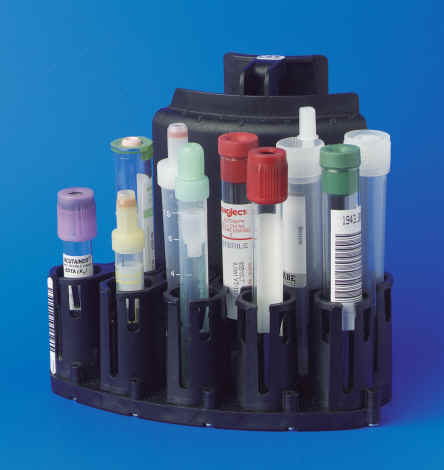
Erroneous type identification and handling of sample containers can lead to fatal damage and consequently the obliteration of the sample itself. To avoid this precarious situtation, the handling robot should be equipped with sufficient sensorial capability. Numerous related problems commonly can be solved by vision solutions at reasonable cost. Thus, the medical robot conceived for the automated handling and opening was augmented in this work by a dedicated vision system for tube type detection and assessment. The following figure exemplifies important steps and options in the design and reconfiguration of the medical robot vision system:
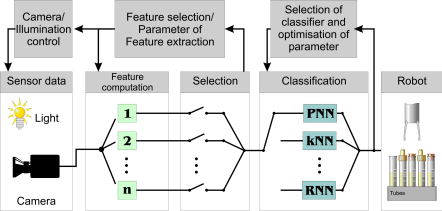
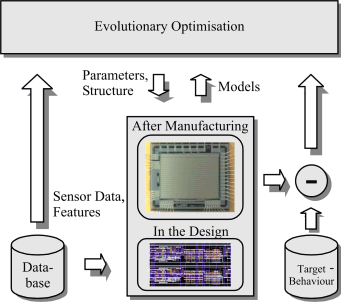
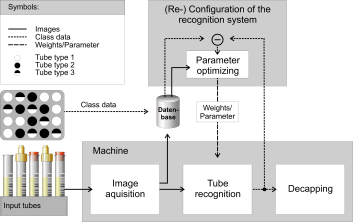
In the current state, only a fraction of the system is reconfigurable by automated learning mechanism. With regard to cost constraints and feasibility issues of a real-world industrial application, the need for reconfiguration for different phases in the product life time was assessed. Current emphasis of self-calibration is on the support of calibration activities required at customers installation to avoid the need for service staff presence. The baseline considerations are summarized in the following figure:
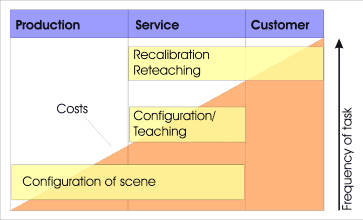
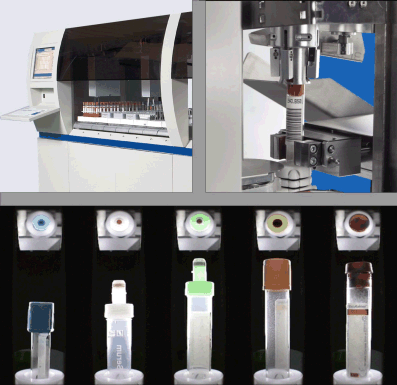
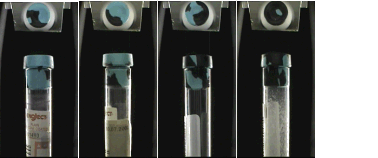
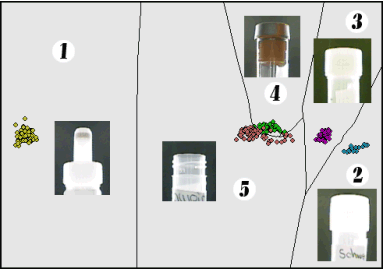
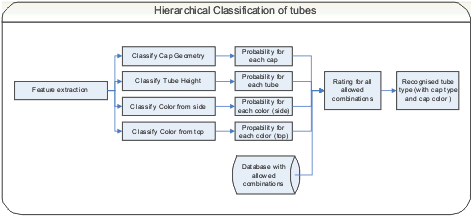
The following tables exemplify typical system performance by relevant benchmark data collected from several installation sites:
Total of analysed tubes in test sets: |
19.993 |
Number of sample sets: |
17 |
Number of different machines: |
16 |
Size of sample sets: |
168-3856 |
Number of samples per class in training sets |
20 - 100 |
Number of Cap-Types per sample set: |
5-18 |
Number of combinations of Cap and Colour: |
7-37 |
|
Correct |
Wrong |
Rejected |
Correct |
Wrong |
Rejected |
Tube types |
98.97 |
0.03 |
1.00 |
19'993 |
6 |
202 |
CapsColors |
98.78 |
0.06 |
1.16 |
19'955 |
12 |
234 |
The outlined system and its derivatives are in use on more than 250 installations world wide. Current research focuses on potential system improvement, e.g., by employing support-vector-machines (SVM) in the decision making or advanced feature computation and fusion techniques. In particular, further advance of system design automation and reconfiguration capabilitiy is in the focus of the ongoing work. The objective is to obtain improved robustness to deviations/drift/aging, aleviated adaptation to meet task modifications along with improved recognition ability.
| Status: | running, duration 06/1999-03/2002, continued until present as doctoral project | ||
| Partner: | Streamline-GmbH (Now: Olympus Diagnostica Labautomation GmbH) | ||
| Financing: | Streamline-GmbH (Now: Olympus Diagnostica Labautomation GmbH) | ||
| Contact: | Prof. Dr.-Ing. Andreas König | ||
| Contributors: | Michael Eberhardt and Andreas König | ||
| Publications: | |||
| M. Eberhardt, R. Hecht und A. König. Einsatz des Konzepts Machine-in-the-Loop-Learning zum individuellen, robusten Anlernen von Laborrobotersystemen. KI Zeitschrift, Ausgabe 02/02, S. 44-47, 2002. | |||
| Michael Eberhardt, Siegfried Roth, and Andreas König. Industrial Application of Machine-In-the-Loop-Learning for a Medical Robot Vision System - Concept and Comprehensive Field Study. In special issue on Advances on Computer-based Biological Signal Processing, of the Journal Computers and Electrical Engineering (CEE), Elsevier, 2008. | |||